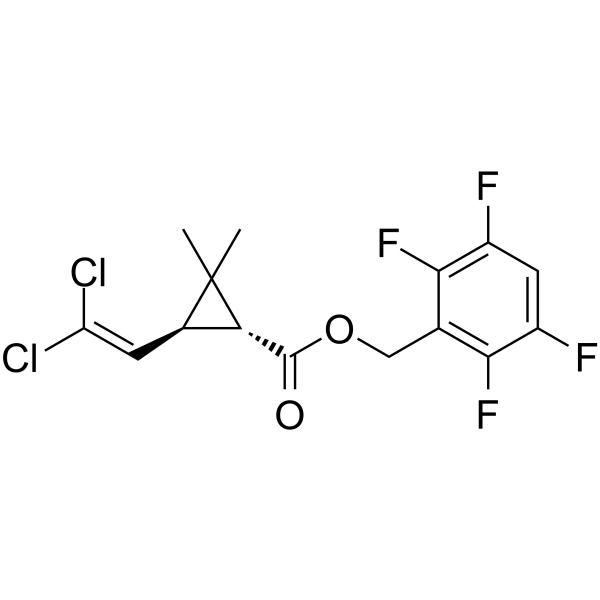
Transfluthrin
CAS No. 118712-89-3
Transfluthrin( —— )
Catalog No. M28882 CAS No. 118712-89-3
Transfluthrin is a volatile pyrethroid insecticide that targets insect voltage-gated sodium channels (VGSC).
Purity : >98% (HPLC)
 COA
COA
 Datasheet
Datasheet
 HNMR
HNMR
 HPLC
HPLC
 MSDS
MSDS
 Handing Instructions
Handing Instructions
| Size | Price / USD | Stock | Quantity |
| 5MG | 45 | Get Quote |


|
| 10MG | 68 | Get Quote |


|
| 25MG | 115 | Get Quote |


|
| 50MG | 173 | Get Quote |


|
| 100MG | 258 | Get Quote |


|
| 200MG | 388 | Get Quote |


|
| 500MG | Get Quote | Get Quote |


|
| 1G | Get Quote | Get Quote |


|
Biological Information
-
Product NameTransfluthrin
-
NoteResearch use only, not for human use.
-
Brief DescriptionTransfluthrin is a volatile pyrethroid insecticide that targets insect voltage-gated sodium channels (VGSC).
-
DescriptionTransfluthrin is a volatile pyrethroid insecticide that targets insect voltage-gated sodium channels (VGSC).
-
In Vitro——
-
In Vivo——
-
Synonyms——
-
PathwayOthers
-
TargetOther Targets
-
Recptor——
-
Research Area——
-
Indication——
Chemical Information
-
CAS Number118712-89-3
-
Formula Weight371.15
-
Molecular FormulaC15H12Cl2F4O2
-
Purity>98% (HPLC)
-
Solubility——
-
SMILESCC1(C)[C@H](C=C(Cl)Cl)[C@@]1(Cc1c(F)c(F)cc(F)c1F)C(O)=O
-
Chemical Name——
Shipping & Storage Information
-
Storage(-20℃)
-
ShippingWith Ice Pack
-
Stability≥ 2 years
Reference
1.Lu Shi, et al. A Potential Anti-cancer Compound Separated from the Chloroform Extract of the Chinese Medicine Formula Shenqi San. Curr Med Sci. 2020 Feb;40(1):138-144.
molnova catalog



related products
-
FMOC-NIP-OH
FMOC-NIP-OH is a piperidinecarboxylic acid derivative.
-
Vonlerolizumab
Vonlerolizumab(MOXR 0916) is a humanized IgG agonistic OX40-specific monoclonal antibody with potential antitumor activity for the study of tumors and immune diseases.
-
Dehydrovomifoliol
Dehydrovomifoliol could be a marker of Polish heather honey. Dehydrovomifoliol exhibits moderate acetylcholinesterase (AChE) inhibitory activities.



 Cart
Cart
 sales@molnova.com
sales@molnova.com


